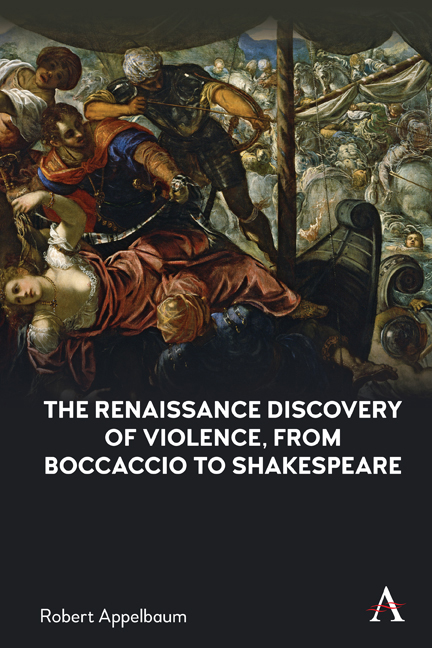Book contents
- Frontmatter
- Dedication
- Contents
- A Note on the Texts
- Acknowledgments
- Preface
- Chapter One Overture: The Show of Violence
- Chapter Two The Moral Economy of Violence in the Renaissance Novella Collection: Straparola, Bandello and Marguerite de Navarre
- Chapter Three Pacifism, Erasmus and More
- Chapter Four Violence as Labor: The Heroic Narrative
- Chapter Five “Tragedy Shows Us What We Must Flee From”
- Afterword
- Select Bibliography
- Index
Chapter Two - The Moral Economy of Violence in the Renaissance Novella Collection: Straparola, Bandello and Marguerite de Navarre
Published online by Cambridge University Press: 16 December 2021
- Frontmatter
- Dedication
- Contents
- A Note on the Texts
- Acknowledgments
- Preface
- Chapter One Overture: The Show of Violence
- Chapter Two The Moral Economy of Violence in the Renaissance Novella Collection: Straparola, Bandello and Marguerite de Navarre
- Chapter Three Pacifism, Erasmus and More
- Chapter Four Violence as Labor: The Heroic Narrative
- Chapter Five “Tragedy Shows Us What We Must Flee From”
- Afterword
- Select Bibliography
- Index
Summary
1. Asymmetrical Violence and Its Moral Economy
A village priest in Emilia-Romagna is tricked out of a mule he bought by three local men known to be robbers. The priest, named Scarpacifico (“fig shoe”), discovering that he has been duped, gets his revenge. First he tricks the robbers into buying a goat for 50 florins, a large sum, having caused them to believe the goat has the magic power of delivering oral messages. They find out to their loss that the goat is only a goat. Next, when they return to the priest's house to murder him, he tricks them into buying what they think is a magic bagpipe for the very large sum of two hundred florins, and then into stabbing their own wives to death. (They thought that blowing the bagpipe up their wives’ asses would bring them back to life.) The robbers respond by abducting the priest, tying him up in a sack, and preparing to kill him by throwing him into a river. But the priest gets out of danger. While the robbers go off to check for their safety, a shepherd comes by and espies the priest, and at the priest's call for help the shepherd lets him out of the sack. Now the priest tricks the shepherd into climbing into the sack in his place and allowing himself to be tied up, making the shepherd believe that in the end he will get to marry a princess. The robbers return and throw the sack into the river, but as they walk away from the scene they see the priest, tending a large flock of sheep. The priest tells them that when he was tied in a sack and thrown into the river, spirits of the seas caused him safely to return to land and acquire the sheep. “Ah! Father Scarpacifico,” they cry out, “will you do us a good turn? Will you put us into sacks and throw us in the river? Then, you see, we shall no longer have need to be highwaymen and rogues, and will live as honest shepherds.” The priest complies, ties them up in sacks, and throws them into the river.
- Type
- Chapter
- Information
- Publisher: Anthem PressPrint publication year: 2021

